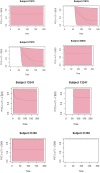Longitudinal-Survival Models for Case-Based Tuberculosis Progression
- PMID: 33968866
- PMCID: PMC8100325
- DOI: 10.3389/fpubh.2021.543750
Longitudinal-Survival Models for Case-Based Tuberculosis Progression
Abstract
Introduction: Tuberculosis (TB) disease continues to be responsible for a high global burden with an estimated 10 million people falling ill each year and an estimated 1.45 million deaths. Widely carried out analyses to utilize routine data coming from this disease, and well-established in literature, have paid attention to time-to-event with sputum smear results being considered only at baseline or even ignored. Also, logistic regression models have been used to demonstrate importance of sputum smear results in patient outcomes. A feature presented by this disease, however, is that each individual patient is usually followed over a period of time with sputum smear results being documented at different points of the treatment curve. This provides both repeated measures and survival times, which may require a joint modeling approach. This study aimed to investigate the association between sputum smear results and the risk of experiencing unfavorable outcome among TB patients and dynamically predict survival probabilities. Method: A joint model for longitudinal and time-to-event data was used to analyze longitudinally measured smear test results with time to experiencing unfavorable outcome for TB patients. A generalized linear mixed-effects model was specified for the longitudinal submodel and cox proportional hazards model for the time-to-event submodel with baseline hazard approximated using penalized B-splines. The two submodels were then assumed to be related via the current value association structure. Bayesian approach was used to approximate parameter estimates using Markov Chain Monte Carlo (MCMC) algorithm. The obtained joint model was used to predict the subject's future risk of survival based on sputum smear results trajectories. Data were sourced from routinely collected TB data stored at National TB Program database. Results: The average baseline age was 35 (SD: 15). Female TB patients constituted 36.42%. Patients with previous history of TB treatment constituted 6.38% (event: 15.25%; no event: 5.29%). TB/HIV co-infection was at 31.23% (event: 47.87%; no event: 29.20%). The association parameter 1.03 (CI[1.03,1.04]) was found to be positive and significantly different from zero, interpreted as follows: The estimate of the association parameter α = 1.033 denoted the log hazard ratio for a unit increase in the log odds of having smear positive results. HIV status (negative) 0.47 (CI [0.46,49]) and history of TB treatment (previously treated) (2.52 CI [2.41,2.63]), sex (female) (0.82 CI [0.78,0.84]), and body mass index (BMI) categories (severe malnutrition being reference) were shown to be statistically significant. Conclusion: Sputum smear result is important in estimating the risk to unfavorable outcome among TB patients. Men, previously treated, TB/HIV co-infected and severely malnourished TB patients are at higher risk of unfavorable outcomes.
Keywords: B splines; Markov Chain Monte Carlo method; current value; joint model; tuberculosis.
Copyright © 2021 Kiplimo, Kosgei, Mwangi, Onyango, Ogero and Koske.
Conflict of interest statement
The authors declare that the research was conducted in the absence of any commercial or financial relationships that could be construed as a potential conflict of interest.
Figures



References
-
- WHO . WHO Global Tuberculosis Report. (2019). Available online at: https://www.who.int/tb/publications/global_report/en/
-
- WHO . The End TB Strategy. Indian Journal of Community Meds. (2015). Available online at: https://www.who.int/tb/strategy/End_TB_Strategy.pdf
-
- Rizopoulos D. Joint Models for Longitudinal and Time-to-Event Data with Applications in R. London: Chapman and Hall; (2012). 10.1201/b12208 - DOI
MeSH terms
LinkOut - more resources
Full Text Sources
Other Literature Sources
Medical

